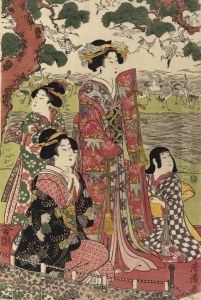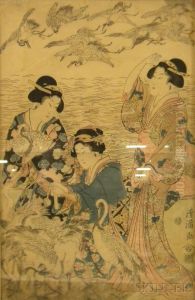Torii Kiyomine Paintings
Torii Kiyomine was a Japanese ukiyo-e artist of the Torii school, which was known for its association with the kabuki theatre in Edo (modern-day Tokyo). Born in 1786, Kiyomine was the grandson of the renowned Torii Kiyomitsu and the son of Torii Kiyonaga, both of whom were prominent figures in the world of ukiyo-e, a genre of woodblock prints and paintings that flourished in Japan from the 17th through 19th centuries.
Kiyomine was trained in the art of woodblock printing by his father and inherited the family tradition of producing yakusha-e, prints depicting actors and scenes from kabuki theater. However, Kiyomine's career spanned a period of transition in ukiyo-e, as the genre began to evolve with the introduction of new subjects, such as landscapes and bijinga (pictures of beautiful women), under the influence of artists like Katsushika Hokusai and Utagawa Hiroshige.
While Kiyomine continued to produce prints in the traditional style of his forebears, his work also reflected the changing tastes of the time. He adapted to the shifts in the ukiyo-e market by creating prints that incorporated elements of the emerging styles. Nevertheless, Kiyomine's reputation did not reach the same heights as that of his father or grandfather, and the Torii school's dominance in kabuki-related art gradually waned during the 19th century.
Kiyomine's legacy includes a body of work that captures the vibrant cultural scene of Edo during a time of artistic transformation. His prints serve as a historical record of the kabuki theater and offer insight into the evolution of the ukiyo-e genre. Kiyomine passed away in 1868, leaving behind a contribution to the Torii lineage and the broader world of Japanese art.

